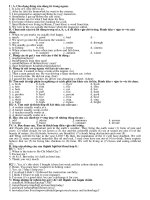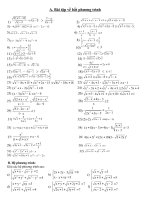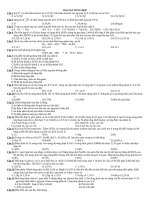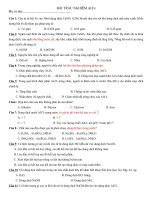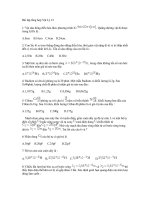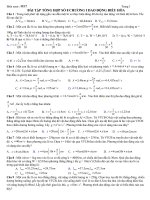- Trang chủ >>
- Đề thi >>
- Đề thi lớp 1
Bài tập tổng hợp -B1-14, B2-14, B3-14
Bạn đang xem bản rút gọn của tài liệu. Xem và tải ngay bản đầy đủ của tài liệu tại đây (90.82 KB, 4 trang )
<span class='text_page_counter'>(1)</span><div class='page_container' data-page=1>
Rev. Inst. Med. trop. S. Paulo
43 (5):247-250, September-October, 2001.
(1) Centre for Diagnostics and Research in Avian Pathology (CDPA), Federal University of Rio Grande do Sul /UFRGS, RS, Brazil.
(2) Federal University of Santa Maria/UFSM, RS, Brazil.
(3) Laboratory of Development and Production at the Centre of Biotechnology of Federal University of Rio Grande do Sul (CENBIOTENZIMAS<sub>), RS, Brazil.</sub>
<b>Correspondence to: Dra. Luciana Ruschel dos Santos, Alberto Torres 158 apt. 304, 95900-000 Lajeado, RS, Brazil. E-mail: </b>
<b>POLYMERASE CHAIN REACTION (PCR) FOR THE DETECTION OF Salmonella IN ARTIFICIALLY</b>
<b>INOCULATED CHICKEN MEAT</b>
<b>Luciana Ruschel dos SANTOS(1), Vladimir Pinheiro do NASCIMENTO(1), Sílvia Dias de OLIVEIRA(1), Maristela Lovato FLORES(2), Alexandre Pontes PONTES(1), Aldemir</b>
<b>Reginato RIBEIRO(1), Carlos Tadeu Pippi SALLE(1) & Rui Fernando Félix LOPES(3)</b>
<b>SUMMARY</b>
<i>The aim of this study was to develop a polymerase chain reaction (PCR) protocol for the detection of Salmonella in artificially</i>
<i>contaminated chicken meat. Tests were performed with different dilutions of Salmonella Typhimurium or Salmonella Enteritidis cells</i>
(10-7<sub>, 10</sub>-8<sub> or 10</sub>-9<sub> CFU/mL) inoculated in chicken meat samples, in order to establish the limits of detection, incubation times (0, 6, 8</sub>
and 24 hours of pre-enrichment in PBW 1%) and three DNA extraction protocols (phenol-chloroform, thermal treatment and thermal
treatment and Sephaglass). The assay was able to detect until 10-9<i><sub> CFU/mL of initial dilution of Salmonella cells inoculated in chicken</sub></i>
<i>meat, which allows detection of Salmonella within 48 hours, including 24 hours of pre-enrichment and using the phenol-chloroform</i>
DNA extraction protocol. As the results are obtained in a shorter time period than that of microbiological culture, this procedure will
<i>be useful in the methodology for detection of Salmonella in chicken.</i>
<i><b>KEYWORDS: Salmonella; PCR; Chicken meat.</b></i>
<b>INTRODUCTION</b>
<i>Salmonella infections may be severe, especially in very young, older or</i>
immunodepressed people, with a possible infecting dose for healthy persons
of 105 <sub>to 10</sub>7<sub> CFU </sub>7<sub>. In the State of Rio Grande do Sul, Brazil, during the</sub>
period of 1994 to 1995, the number of cases of foodborne outbreaks clinically
compatible with salmonellosis increased, many of them associated with the
consumption of poultry products or products including poultry as an
ingredient. During the same period, a survey of the contamination indices
<i>for Salmonella in chicken carcasses, performed at the Centre for Diagnostics</i>
and Research in Avian Pathology (CDPA), showed that 17.5% of the 1300
<i>carcasses examined were positive for Salmonella</i>3<sub>.</sub>
Polymerase chain reaction (PCR) is a molecular biology technique
which has taken up an increasingly significant space in the field of
laboratory diagnostics, allowing the detection of various pathogens, such
<i>as Listeria monocytogenes, Campylobacter sp., Yersinia enterocolitica,</i>
<i>Vibrio cholerae, Shigella flexneri, Escherichia coli and Salmonella, in</i>
different kinds of food, such as meat and milk. PCR can reduce the time
required to detect and identify the agent1,4<sub>. Thus, the purpose of this</sub>
<i>study was to establish a PCR protocol in order to detect Salmonella in</i>
experimentally infected chicken meat samples.
<b>MATERIAL AND METHODS</b>
<b>Bacterial strains and inoculation of food products: Aliquots of</b>
10 m<i>L of Salmonella Typhimurium (ATCC 14028), Salmonella</i>
Enteritidis (ATCC 1980) and 18 other bacteria (Table 1) maintained in
DTS (PI9500076-3 INPI) were transferred to BHI broth (Brain Heart
Infusion, Merck) and incubated for 18 h at 37 o<i><sub>C. The Salmonella samples</sub></i>
were diluted in buffered peptone water 0.1% (PBW, Merck) until 10-9<sub>,</sub>
<i>and then counts of S. Enteritidis (10</i>-7<i><sub>:120 CFU) and S. Typhimurium</sub></i>
(10-7<sub>:200 CFU) were determined in plate count agar (PCA, Merck). A</sub>
pool of the other 18 bacteria was obtained by mixing 1mL of each
bacterium in a sterile tube. The diluted 10-2 <sub>pool contained between</sub>
10-5<sub> to 10</sub>-6<sub> CFU/g.</sub>
<b>Sample preparation: Thirty-two samples of chicken meat were used.</b>
From each sample, 25 grams were weighted in sterile bags (Seward
Medical Stomacher®<sub> 400 sterile bags) and inoculated with 1 mL of a</sub>
dilution (10-7<sub>,10</sub>-8<sub> or 10</sub>-9<i><sub>) of S. Enteritidis or S. Typhimurium and 1 mL</sub></i>
of the other 18 bacteria pool diluted 10-2 <sub>. In two of the samples, only the</sub>
pool was inoculated. Finally, 225 mL of PBW 1% were added and
homogenized in a Stomacher (Laboratory Blender Stomacher 400,
Seward Medical, England) for 30 seconds. Aliquots intended to be used
in the PCR were collected immediately after homogenization, and after
6, 8 and 24 hours of pre-enrichment in PBW 1% at 37 o<sub>C, in which case</sub>
they were frozen until PCR assays were performed.
<b>Microbiology method: Following 24 hours of preenrichment in</b>
PBW 1%, 0.1 mL was transferred to 9.9 mL of Rappaport-Vassiliadis
(Merck) broth and 1 mL to tetrathionate broth (Merck) for selective
enrichment at 42 o<sub>C and 37 </sub>o<sub>C for 24 h, respectively. One loopful of</sub>
</div>
<span class='text_page_counter'>(2)</span><div class='page_container' data-page=2>
248
SANTOS, L.R.; NASCIMENTO, V.P.; OLIVEIRA, S.D.; FLORES, M.L.; PONTES, A.P.; RIBEIRO, A.R.; SALLE, C.T.P. & LOPES, R.F.F. - Polymerase chain reaction (PCR) for the
<i><b>detection of Salmonella in artificially inoculated chicken meat. Rev. Inst. Med. trop. S. Paulo, 43(5):247-250, 2001.</b></i>
Rambach agar (Merck). The plates were incubated at 37 o<sub>C for 24 h.</sub>
Presumptively positive colonies were inoculated into TSI, LI, SIM, urea
and nutrient agar (Merck). After incubation at 37 o<sub>C for 18-24 h,</sub>
<i>confirmations were done serologically, using Salmonella polyvalent O</i>
and H agglutinating sera (Difco).
<b>DNA extraction using phenol-chloroform, adapted from WILSON</b>
<i>et al.</i>8<sub>: A 1 mL aliquot of each sample was centrifuged (Centrifuge 5415C,</sub>
Germany) at 5000 rpm for 4 min and the supernatant was discarded. The
pellet was suspended in 1 mL of 10 mM Tris - 1 mM EDTA (TE pH 8),
vortexed for 10 s (Pachane tube shaker, Brazil) and the resulting mixture
was centrifuged twice, as described above. The supernatant was discarded
and the pellet was suspended in 350 mL of TE and vortexed for 10 s.
Thirty microlitre of lysozyme (50 mg/mL, Pharmacia Biotech,) was added
to the suspension, and the mixture was vortexed for 10 s and placed on
ice for 30 min to lyse the cells. After lysis, 40 mL of 10% sodium dodecyl
sulphate (SDS, VETEC, Brazil) solution in distilled H<sub>2</sub>O was added and
mixed for 1 min or until it reached an homogeneous, milky suspension.
Forty microlitre of proteinase K solution (20 mg/mL, GibcoBRL) was
then added; the suspension was mixed by inversion, and the resulting
mixture was incubated at 37 °C for one hour in a water bath (Precision,
USA). DNA was extracted by adding 800 mL of phenol pH 7 (Merck) to
a microcentrifuge tube containing the above-described mixture. The tube
was shaked vigorously until a white, milky emulsion was formed and
then centrifuged at 13000 rpm for 1 min. After centrifugation, the aqueous
phase was transferred to a clean microcentrifuge tube containing
150 mL of TE buffer. A 700 mL volume of a 1:1 mixture of phenol
(pH 7) and chloroform-isoamyl alcohol (25:1 vol/vol) was added. The
tube was again shaked vigorously until a white emulsion was formed
and then centrifuged at 13000 rpm for 1 min. Six hundred microlitre of
the aqueous phase were transferred to a clean tube. Approximately
800 mL of chloroform-isoamyl alcohol (25:1) were added, and the tube
was inverted several times before centrifugation as before. Following
centrifugation, 325 mL of the aqueous phase were transferred to a tube
containing 75 mL of 3M sodium acetate pH 7.2 (ACS). The mixture
was mixed briefly with a micropipette. Approximately 1 mL of ethanol
was added and the tube was inverted five or six times prior to being
placed on ice for 10 min. The precipitated DNA was pelleted by
centrifugation for 15 min at 13000 rpm; the supernatant was decanted
and discarded. The open tube of pelleted DNA was inverted on absorbent
paper for 30 min. The pellet was suspended in 50 mL of TE and stored at
–20 o<sub>C.</sub>
<b>DNA extraction with thermal treatment: A 1 mL aliquot of each</b>
sample was centrifuged at 5000 rpm for 4 min and the supernatant was
discarded. The pellet was suspended in 1 mL of TE, vortexed for 10 s and
the resulting mixture was centrifuged twice, as described above. The
supernatant was discarded; the pellet was suspended in 100 mL of TE and
vortexed for 10 s. The sample was placed on a thermal block (Multi-Blok
Heater, Baxter, EUA) at 95 o<sub>C for 10 min. The mixture was centrifuged</sub>
for 20s at 5000 rpm and the supernatant was stored at –20 o<sub>C.</sub>
<b>DNA extraction using thermal treatment and Sephaglass, adapted</b>
<i>from ROSSETI et al.</i>5<b><sub>: One mL of the sample was centrifuged for 10</sub></b>
min at 5000 rpm and the supernatant was discarded. The pellet was
suspended in 200 mL of TE, vortexed for 10 s, and the resulting mixture
was recentrifuged twice as described above. The supernatant was
discarded; the pellet was suspended in 50 mL of TE and vortexed for
10 s. The sample was placed on a thermal block at 95 o<sub>C for 10 min. The</sub>
mixture was centrifuged for 20 s at 5000 rpm and the supernatant was
transferred to a microtube with 5 mL of Sephaglass (Sephaglass TM
BandPrep Kit, Pharmacia Biotech). It was then mixed gently for 5 min
and centrifuged for 1 min at 5000 rpm. After that, the supernatant was
discarded. Approximately 200 mL of ethanol 70% was added and the
resulting mixture gently shaked; the tube was centrifuged for 20 s at
5000 rpm and the supernatant discarded. This last step was repeated
twice. The open tube of pelleted DNA was inverted on absorbent paper
for 30 min. The pellet was suspended in 30 mL of TE, vortexed for 10 s
and centrifuged for 2 min at 14000 rpm. The supernatant was stored at
-20 o<sub>C.</sub>
<i><b>PCR, adapted of RAHN et al.</b></i>4<b><sub>: Reaction mixtures (25 </sub></b>m<sub>L) for each</sub>
sample contained 2.5 mL reaction buffer 10X (15 mM MgCl<sub>2, </sub>500 mM KCL,
100 mM Tris-HCL pH 8.3, (CenbiotEnzimas<sub>), 1.2 </sub>m<sub>L of BSA (8 </sub>m<sub>g/ml),</sub>
5 mM of each deoxyribonucleotide, 5 rmol of each oligonucleotide
( 1 4 9 : 5 ’ G T G A A A T T A T C G C C A C G T T C G G G C A A 3 ' ,
<i>151:5’TCATCGCACACGTCAAAGGAACC3'), 1U of taq DNA</i>
polymerase (CenbiotEnzimas<sub>) and 20 ng purified DNA. The cycling</sub>
programme was set in a Perkin Elmer Gen Amp PCR System 2400
thermocycler (Perkin Elmer Cetus, Norwalk, CT, USA). Samples were
denatured at 94 °C for 5 min. Thirty-five cycles of amplification were
run for 30 s at 94 °C, 30 s at 54 °C and 30 s at 72 °C, with the final
extension continuing for 7 min. Twenty-five microlitre aliquots of the
reaction mixtures were electrophoresed through 2.0% agarose gel and
fragments were revealed by staining with ethidium bromide.
<b>RESULTS AND DISCUSSION</b>
<i>In the specificity assay, all samples of Salmonella DNA tested were</i>
amplified, generating a characteristic 284 bp product. These results are
<b>Table 1</b>
<i>Non- Salmonella strains examined in this study</i>
Strains Source
<i>Escherichia coli</i> ATCC 25922
<i>Enterobacter cloacae</i> LARA
<i>Enterobacter aerogenes</i> ATCC 13048
<i>Proteus mirabilis</i> LARA
<i>Proteus vulgaris</i> ATCC 13315
<i>Pseudomonas fluorescens</i> LARA 0612
<i>Schewanella putrefaciens</i> LARA 2122
<i>Bacillus cereus</i> LARA
<i>Bacilus subtilis</i> LARA
<i>Bacillus alvei</i> LARA
<i>Bacillus laterosporus</i> LARA
<i>Klebsiella pneumoniae</i> ATCC 13883
<i>Citrobacter freundii</i> LARA 0676
<i>Staphylococcus aureus</i> ATCC 25923
<i>Staphylococcus epidermidis</i> ATCC 12228
<i>Crysiomonas luteola</i> LARA 6491
<i>Aeromonas sobria</i> LARA 4578
<i>Aeromonas hydrofila</i> LARA 5621
</div>
<span class='text_page_counter'>(3)</span><div class='page_container' data-page=3>
SANTOS, L.R.; NASCIMENTO, V.P.; OLIVEIRA, S.D.; FLORES, M.L.; PONTES, A.P.; RIBEIRO, A.R.; SALLE, C.T.P. & LOPES, R.F.F. - Polymerase chain reaction (PCR) for the
<i><b>detection of Salmonella in artificially inoculated chicken meat. Rev. Inst. Med. trop. S. Paulo, 43(5):247-250, 2001.</b></i>
249
<i>similar to those of RAHN et al.</i>4<i><sub>, that studying 630 isolates of Salmonella</sub></i>
<i>and 142 of other bacteria, amplified all the samples of Salmonella, except</i>
<i>S. Litchfield and S. Senftenberg. In the authors’ opinion, the apparent</i>
<i>absence of gene invA in these two serovars suggests that these organisms</i>
are not invasive, or that they have alternative pathways to penetrate cells,
with, an as yet, unknown pathogenic potential. One of the critical points
of the technique used is the choice of the sequence to be amplified,
which must be common to most of the serovars and do not present
homology with other organisms. In the present study, when using primers
<i>149 and 151, which are derived from gene invA and code for proteins</i>
related to cell invasion, a non-specific amplification of DNA of a sample
<i>of Escherichia coli was observed, which could be safely differentiated</i>
<i>from Salmonella, since the former presents a band of around 300 bp</i>
(Fig. 1) and, by so, it does not allow any misinterpretation of the results.
When assays were performed using artificially contaminated chicken
meat samples after 24 hours of pre-enrichment and using the DNA
extraction protocol with phenol-chloroform, until 10-9<sub> CFU/mL of initial</sub>
<i>dilution of Salmonella cells inoculated in chicken meat could be detected</i>
(Table 2). The microbiology method used presented the same detection
limit, but supplied results after 96 hours of analysis. In this particular
<i>aspect, these results are not in accordance with those from MAHON et</i>
<i>al.</i>2<sub>, who demonstrated, experimentally, a greater sensitivity of the PCR</sub>
<i>to detect Salmonella in chicken skin samples, when compared with that</i>
<i>of the microbiological culture. RAHN et al.</i>4<sub>, abolishing the </sub>
<i>pre-enrichment phase, were not able to amplify Salmonella DNA directly</i>
from chicken litter and carcasses. Their results are in accordance with
those from the current experiment, where negative results were obtained
when meat samples were processed immediately after homogenization
with peptone water, or at the sixth and eight hour of the incubation period
<i>(Table 2). These results agree with those from STONE et al.</i>6<sub>, who</sub>
indicated that the inclusion of a pre-enrichment step presents advantages
over the direct extraction of DNA, since the enrichment broth are
relatively cheap, require little manipulation, dilute substances which could
inhibit PCR and increase the number of bacterial cells. On the other
hand, substances found in meat samples, such as blood and fat, could
also interfere in the PCR results.
Thus, the capacity to isolate the target bacteria, as well as the influence
of matrix components, could be limiting factors for PCR reliability. These
problems could be overcome with procedures such as dilutions of the
sample, previous isolation of the pathogens being studied, and DNA
extraction protocols, as well as corrections in PCR reagent concentrations.
In this experiment, when the protocols for extraction with thermal
treatment and Sephaglass were used, negative results were observed at
all incubation periods tested (Table 2). Differently, the protocol for
phenol-chloroform extraction supplied positive results after 24 hours of
sample’s pre-enrichment. With this protocol, the reduction of analysis
time from approximately 96 hours, with microbiology method, to 48
hours with PCR, appears to be the main advantage of the technique,
since the detection limits of both methods (PCR and conventional
microbiology) were the same (Table 2 ). The specificity of PCR is another
indication of its good applicability in diagnostic routines. However, there
are reports indicating the occurrence of false negative results when
naturally contaminated chicken meat samples are analyzed by the PCR
method. Thus, the next stage of these experiments should include the
comparison between the PCR protocol developed in this study and
<i>microbiological analysis for the detection of Salmonella in naturally</i>
infected chicken meat samples.
<b>Fig. 1 - Agarose gel electrophoresis of the PCR products obtained when testing the artificially</b>
contaminated chicken meat samples after 24 hours of pre-enrichment and using the DNA
extraction protocol with phenol-chloroform and controls.
<i><b>1- DNA ladder 100 bp; 2- S. Enteritidis 10</b></i>-7 <i><b><sub>control; 3- S. Enteritidis 10</sub></b></i>-8 <i><b><sub>control; 4- S. Enteritidis</sub></b></i>
10-9<i><b><sub> control; 5- chicken meat contaminated with S. Enteritidis 10</sub></b></i>-7<b><sub>; 6- chicken meat</sub></b>
<i>contaminated with S. Enteritidis 10</i>-8<i><b><sub>; 7- chicken meat contaminated with S. Enteritidis 10</sub></b></i>-9<sub>;</sub>
<i><b>8- chicken meat contaminated with S. Typhimurium 10</b></i>-7<b><sub>; 9- chicken meat contaminated with</sub></b>
<i>S. Typhimurium 10</i>-8<i><b><sub>; 10- chicken meat contaminated with S. Typhimurium 10</sub></b></i>-9 <b><sub>; 11- chicken</sub></b>
meat contaminated with pool diluted 10-2<i><b><sub>; 12 and 13- E. coli ATCC 25922; 14- Positive</sub></b></i>
<i><b>control (20 ng Salmonella Typhimurium purified DNA); 15- Negative control; 16- DNA</b></i>
ladder 100 bp.
<b>Table 2</b>
<i>Results of detection of Salmonella in chicken samples artificially contaminated with 10</i>-7<sub>, 10</sub>-8<sub> or 10</sub>-9<i><sub> dilutions of S. Enteritidis or S. Typhimurium and pool of 18</sub></i>
other bacteria by PCR following DNA extractions procedure after four incubation times in PBW 1%
Incubation times in PBW 1%
DNA extraction Zero 6 hours 8 hours 24 hours
procedure and PCR 10-7<sub>, 10</sub>-8<sub> or 10</sub>-9 <sub>10</sub>-7<sub>, 10</sub>-8<sub> or 10</sub>-9 <sub>10</sub>-7<sub>, 10</sub>-8<sub> or 10</sub>-9 <sub>10</sub>-7<sub>, 10</sub>-8<sub> or 10</sub>-9
UFC/mL UFC/mL UFC/mL UFC/mL
Phenol-chloroform negative negative negative positive
Thermal treatment negative negative negative negative
</div>
<span class='text_page_counter'>(4)</span><div class='page_container' data-page=4>
250
SANTOS, L.R.; NASCIMENTO, V.P.; OLIVEIRA, S.D.; FLORES, M.L.; PONTES, A.P.; RIBEIRO, A.R.; SALLE, C.T.P. & LOPES, R.F.F. - Polymerase chain reaction (PCR) for the
<i><b>detection of Salmonella in artificially inoculated chicken meat. Rev. Inst. Med. trop. S. Paulo, 43(5):247-250, 2001.</b></i>
<b>RESUMO</b>
<b>Reaỗóo em cadeia pela polimerase (PCR) para detecỗóo de</b>
<i><b>Salmonella em carne de frango artificialmente contaminada</b></i>
O objetivo deste trabalho foi adequar um protocolo de reaỗóo em
<i>cadeia pela polimerase (PCR) para detecỗóo de Salmonella em carne de</i>
frango artificialmente contaminada. Foram realizados ensaios com
<i>amostras de carne de frango inoculadas com diluiỗừes de Salmonella</i>
<i>Typhimurium ou Salmonella Enteritidis (10</i>-7<sub>, 10</sub>-8<sub> ou 10</sub>-9<sub> UFC/mL),</sub>
procurando-se determinar o limite de detecỗóo da tộcnica, intervalos de
incubaỗóo das amostras (0, 6, 8 ou 24 horas de prộ-enriquecimento em
ỏgua peptonada 1%) e trờs protocolos de extraỗóo de DNA
(fenol-clorofórmio, tratamento térmico ou tratamento térmico e Sephaglass).
<i>Foi possível amplificar DNA de Salmonella nas amostras de carne de</i>
frango inoculadas inicialmente com diluiỗừes de atộ 10-9<sub> UFC/mL,</sub>
utilizando-se protocolo de extraỗóo de DNA por fenol-clorofúrmio e
apús um perớodo de 24 horas de pré-enriquecimento, totalizando 48 horas
de análise. Como os resultados são obtidos mais rapidamente que a
cultura, este procedimento será ỳtil na metodologia para detecỗóo de
<i>Salmonella em carne de frango.</i>
<b>ACKNOWLEDGEMENTS</b>
The authors thank the professionals at the Centre for Diagnostics
and Research in Avian Pathology (CDPA), Professor Hélio Mauro
Moreira Maia from the Laboratory of Development and Production at
the Centre of Biotechnology of Federal University of Rio Grande do Sul
(CENBIOTENZIMAS<sub>) and Dulce Maria Schuch for her technical assistance.</sub>
This research was partially carried out with financial support from the
Research Support Foundation of the State of Rio Grande do Sul
(FAPERGS) and the Brazilian National Council of Research (CNPq).
<b>REFERENCES</b>
1. COHEN, N.D.; WALLIS, D.E. & NEIBERGS, H.L. - Comparison of the PCR using
genus-specific oligonucleotide primers and microbiologic culture for the detection
<i><b>of Salmonella in drag-swabs from poultry houses. Poult. Sci., 73: 1276-1281, 1994.</b></i>
2. MAHON, J.; MURRHY, C.K.; JONES, P.W. & BARROW, P.A. - Comparison of multiplex
<i>PCR and standard bacteriological methods of detecting Salmonella on chicken skin.</i>
<b>Lett. appl. Microbiol., 19: 169-172, 1994.</b>
<i>3. NASCIMENTO, V.P.; SILVA, A.P. & SALLE, C.T.P. - Ocorrờncia de Salmonella sp. em</i>
<i>carcaỗas de frangos industrialmente processadas. In: CONFERÊNCIA APINCO DE</i>
CIÊNCIA E TECNOLOGIA AVÍCOLA, Santos, 1996. p. 81.
<i>4. RAHN, K.; DE GRANDIS, S.A.; CLARKE, R.C. et al. - Amplification of an invA gene</i>
<i>sequence of Salmonella typhimurium by PCR as a specific method of detection of</i>
<i><b>Salmonella. Molec. cell. Probes, 6: 271-279, 1992.</b></i>
<i>5. ROSSETTI, M.L.R.; JARDIM, V.F.S.; RODRIGUES, A.R. et al. - Improvement of</i>
<i>Mycobacterium tuberculosis detection in clinical samples using DNA purified by</i>
<b>glass matrix. J. microbiol. Meth., 28: 139-146, 1997.</b>
<i>6. STONE, G.G.; OBERST, R.D.; HAYS, M.P. et al. - Detection of Salmonella typhimurium</i>
from rectal swabs of experimentally infected beagles by short cultivation and
<b>PCR-hybridization. J. clin. Microbiol., 33: 1292-1295, 1995.</b>
<i>7. VARNAN, A.H. & EVANS, M.G. - Salmonella. In: VARNAN, A.H. & EVANS, M.G.</i>
<b>Foodborn pathogens. St. Louis, Mosby Year Book; Wolfe Publ., 1991. p. 51-85.</b>
8. WILSON, M.A.; RIMLER, R.B. & HOFFMAN, L.J. - Comparison of DNA fingerprints
<i><b>and somatic serotypes of serogroup B and E Pasteurella multocida isolates. J. clin.</b></i>
<b>Microbiol., 30: 1518-1524, 1992.</b>
</div>
<!--links-->
